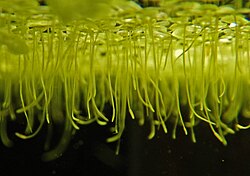アオウキクサ属
| アオウキクサ属 | |||||||||||||||||||||
|---|---|---|---|---|---|---|---|---|---|---|---|---|---|---|---|---|---|---|---|---|---|
  (上) Lemna aequinoctialis, (下) コウキクサ
| |||||||||||||||||||||
| 分類 | |||||||||||||||||||||
| |||||||||||||||||||||
| 学名 | |||||||||||||||||||||
| Lemna L., 1753[1] | |||||||||||||||||||||
| タイプ種 | |||||||||||||||||||||
| コウキクサ Lemna minor L., 1753[2] | |||||||||||||||||||||
| シノニム | |||||||||||||||||||||
| |||||||||||||||||||||
| 英名 | |||||||||||||||||||||
| duckweed[3] | |||||||||||||||||||||
| 下位分類 | |||||||||||||||||||||
アオウキクサ属 (学名: Lemna) はサトイモ科ウキクサ亜科に属する水草の1属である。池や水路など淡水域に分布し、多くは水面に生育する。ふつう葉状体からは1本の根が伸びている (右図)。また葉状体基部側面から新たな葉状体を形成し、出芽状に増殖する (右図)。世界中に分布し、15種ほどが知られる。日本からはアオウキクサ、コウキクサ、イボウキクサ、ヒンジモなど約9種が報告されている。
特徴
[編集]小さな水生植物であり、多くは水面に浮かんでいるが、水中に生育する種もいる (ヒンジモ)[1][4]。植物体は葉状体 (フロンド[5] frond; 葉と茎の区別がない) と根からなる[1][4] (下図1)。葉状体表面は緑色、裏面は緑色または紫色を帯びる[4] (下図1b)。葉状体裏面が大きく膨潤している種もいる[4] (イボウキクサ; 下図1b)。葉状体には1–5脈があり、基部から掌状に伸びている[4][6]。色素細胞 (pigment cell) を欠く[4]。基本的に1個の葉状体の裏面から1本の根が生じているが (下図1)、根を欠くこともある[1][4][6][7]。根の基部は根鞘に囲まれ、根毛を欠き、先端は根嚢 (根帽) で覆われている[4][8]。葉状体基部側面から新たな葉状体を形成して出芽状に増殖する[4] (下図1c)。ふつう複数の葉状体が連結した状態でいる[1][4][6] (下図1c)。

花は葉状体基部側面につく[4] (左図2)。花は2個の雄しべと1個の雌しべからなり、1枚の葉的器官で覆われている[1][4] (2個の雄花と1個の雌花とされることもある[1][6]) (左図2)。雄しべの葯は4花粉嚢からなる[1][4] (左図2)。果実は1–6個の種子を含む[1][4]。種子にはふつう縦の肋がある[4][6]。
分布・生態
[編集]世界中 (南北アメリカ、アフリカ、ヨーロッパ、西アジア、南アジア、東アジア、東南アジア、オーストラリアなど) に広く分布している[1][6]。
池沼や水路、水田など、淡水止水域または緩やかな流水域の水面に生育する (右図3a)。例外的に、ヒンジモは水中を浮遊して生育する (右図3b)。比較的きびしい冬期がある地域では、休眠芽 (越冬芽、殖芽) を形成、または種子の形で越冬する[7]。
人間との関わり
[編集]ウキクサ亜科の他の種と同様、アオウキクサ属の種も一般的に増殖が極めて速いため、さまざまな応用研究に用いられている。例として、有用動物の餌[9][10][11]、バイオマス燃料[12]、有機物分解の効率化[13]、栄養塩 (窒素やリン) 除去[14]、有毒物質の除去 (バイオレメディエーション)[15][16]、毒性試験[17]などがある。
系統と分類
[編集]アオウキクサ属にはおよそ14種が知られており[1][4] (下表)、一般的に4節に分類される[18]。属内の系統関係については、分子系統解析から下記のような仮説が示されている[19]。日本からは、アオウキクサ属の種としてアオウキクサ、ナンゴクアオウキクサ、ヒナウキクサ、チリウキクサ、イボウキクサ、コウキクサ、ムラサキコウキクサ、キタグニコウキクサ、ヒンジモが報告されている (帰化種を含む)[6][注 1]。日本からはチビウキクサ (Lemna perpusilla) も報告されているが、これはヒナウキクサの誤認ともされる[20]。いずれの種も形態が単純であり、また生育環境による変異が大きいため分類は難しく、生態的情報 (葉状体越冬の有無など) を必要とする場合もある[7]。
| |||||||||||||||||||||||||||||||||||||||||||||||||||||||||||||||||||||||||||||||||||||||||||||
| ウキクサ亜科 (特にアオウキクサ属) の系統仮説[19] |
アオウキクサ属の種までの分類体系[1][21]
|
脚注
[編集]注釈
[編集]- ^ 海外ではアオウキクサとナンゴクアオウキクサは区別されないことも多い[1][3] (この場合 Lemna aequinoctialis の学名を充てる)。
- ^ 日本からも報告されているが、ヒナウキクサの誤認ともされる[20]。
出典
[編集]- ^ a b c d e f g h i j k l m n o p q r s “Lemna”. Plants of the World Online. Kew Botanical Garden. 2021年7月4日閲覧。
- ^ Wunderlin, R. P., Hansen, B. F., Franck, A. R. & Essig, F. B. (2021年). “Lemna”. Atlas of Florida Plants. Institute for Systematic Botany, University of South Florida, Tampa. 2021年7月4日閲覧。
- ^ a b GBIF Secretariat (2021年). “Lemna”. GBIF Backbone Taxonomy. 2021年7月4日閲覧。
- ^ a b c d e f g h i j k l m n o p Flora of China Editorial Committee (2010年). “Lemna”. Flora of China. Missouri Botanical Garden and Harvard University Herbaria. 2021年7月4日閲覧。
- ^ “Lemnoideae ウキクサ亜科”. 植物発生進化学:読む植物図鑑. 基礎生物学研究所生物進化研究部門 (2015年10月9日). 2021年6月20日閲覧。
- ^ a b c d e f g 邑田仁 (2015). “アオウキクサ属”. In 大橋広好, 門田裕一, 邑田仁, 米倉浩司, 木原浩 (編). 改訂新版 日本の野生植物 1. 平凡社. pp. 107–108. ISBN 978-4582535310
- ^ a b c 角野康郎 (1994). “アオウキクサ属”. 日本水草図鑑. 文一総合出版. pp. 72–73. ISBN 978-4829930342
- ^ 熊沢 正夫 (1979). “根の通性”. 植物器官学. 裳華房. pp. 304−312. ISBN 978-4785358068
- ^ Men, B. X., Ogle, B. & Lindberg, J. E. (2001). “Use of duckweed as a protein supplement for growing ducks”. Asian-Australasian Journal of Animal Sciences 14 (12): 1741-1746. doi:10.5713/ajas.2001.1741.
- ^ Gaigher, I.G., Porath, D. & Granoth, G. (1984). “Evaluation of duckweed (Lemna gibba) as feed for tilapia (Oreochromis niloticus × O. aureus) in a recirculating unit”. Aquaculture 41 (3): 235-244.
- ^ Leng, R. A., Stambolie, J. H. & Bell, R. (1995). “Duckweed-a potential high-protein feed resource for domestic animals and fish”. Livestock Research for Rural Development 7 (1): 36.
- ^ Ge, X., Zhang, N., Phillips, G. C. & Xu, J. (2012). “Growing Lemna minor in agricultural wastewater and converting the duckweed biomass to ethanol”. Bioresource Technology 124: 485-488. doi:10.1016/j.biortech.2012.08.050.
- ^ Körner, S., Lyatuu, G. B. & Vermaat, J. E. (1998). “The influence of Lemna gibba L. on the degradation of organic material in duckweed-covered domestic wastewater”. Water Research 32 (10): 3092-3098. doi:10.1016/S0043-1354(98)00054-2.
- ^ Cheng, J., Landesman, L., Bergmann, B. A., Classen, J. J., Howard, J. W. & Yamamoto, Y. T. (2002). “Nutrient removal from swine lagoon liquid by Lemna minor 8627”. Transactions of the ASAE 45 (4): 1003. doi:10.13031/2013.9953.
- ^ Rahmani, G. N. H. & Sternberg, S. P. (1999). “Bioremoval of lead from water using Lemna minor”. Bioresource Technology 70 (3): 225-230. doi:10.1016/S0960-8524(99)00050-4.
- ^ Goswami, C., Majumder, A., Misra, A. K. & Bandyopadhyay, K. (2014). “Arsenic uptake by Lemna minor in hydroponic system”. International Journal of Phytoremediation 16 (12): 1221-1227. doi:10.1080 /15226514.2013.821452.
- ^ Barhoumi, L., Oukarroum, A., Taher, L. B., Smiri, L. S., Abdelmelek, H. & Dewez, D. (2015). “Effects of superparamagnetic iron oxide nanoparticles on photosynthesis and growth of the aquatic plant Lemna gibba”. Archives of Environmental Contamination and Toxicology 68 (3): 510-520. doi:10.1007/s00244-014-0092-9.
- ^ Les, D. H., Landolt, E. & Crawford, D. J. (1997). “Systematics of the Lemnaceae (duckweeds): inferences from micromolecular and morphological data”. Plant Systematics and Evolution 204 (3): 161-177. doi:10.1007/BF00989203.
- ^ a b Tippery, N. P., Les, D. H. & Crawford, D. J. (2015). “Evaluation of phylogenetic relationships in Lemnaceae using nuclear ribosomal data”. Plant Biology 17: 50-58. doi:10.1111/plb.12203.
- ^ a b 角野康郎 (2014). “ヒナウキクサ”. 日本の水草. 文一総合出版. p. 64. ISBN 978-4829984017
- ^ 米倉浩司・梶田忠. “植物和名ー学名インデックスYList”. 2021年7月17日閲覧。
- ^ Halder, S. & Venu, P. (2012). “Lemna landoltii sp. nov.(Lemnaceae) from India”. Taiwania 58 (1): 12-14. doi:10.6165/tai.2013.58.12.
関連項目
[編集]外部リンク
[編集]- “Lemna”. Plants of the World Online. Kew Botanical Garden. 2021年7月4日閲覧。 (英語)
- GBIF Secretariat (2021年). “Lemna”. GBIF Backbone Taxonomy. 2021年7月4日閲覧。 (英語)
- Flora of China Editorial Committee (2010年). “Lemna”. Flora of China. Missouri Botanical Garden and Harvard University Herbaria. 2021年7月9日閲覧。 (英語)










